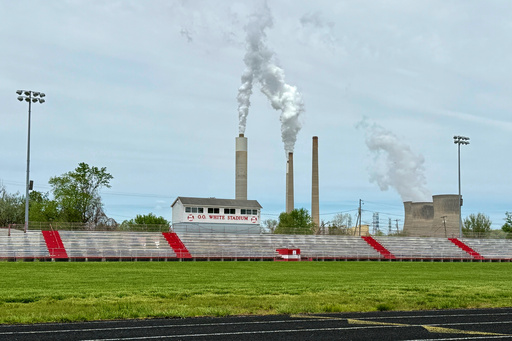FAYETTEVILLE, W.Va. — In a place where time seems to have paused, the winner of the West Virginia Coal Festival teen beauty pageant wanders among the remnants of a coal community abandoned decades ago. Ava Johnson, a 16-year-old with a passion for history, explores the overgrown railroads near the deserted Kay Moor mine in New River Gorge National Park, seeking spikes for her collection. As she surveys the rusted coal tipples and dilapidated processing plants, she imagines them springing back to life.
Johnson is realistic about the future of coal in West Virginia, acknowledging that it will never regain its former stature. Nevertheless, as she navigates the old tracks, she clings to the optimism that resonates in her community about the potential revival of an industry that has provided lucrative employment in her state for nearly 200 years. “You can’t truly appreciate being a West Virginian unless you recognize that people risked their lives daily to improve ours,” she said.
This resurgence of hope is largely attributed to President Donald Trump, who has promulgated executive orders designed to rejuvenate coal, the planet’s most polluting fossil fuel according to experts, and a significant contributor to climate change. Trump, committed since his 2016 presidential bid to “save coal,” has initiated measures to enable mining on federal lands and relax emissions regulations theoretically aimed at reducing coal’s environmental impact.
“All those plants that were closed can be reopened, if modern enough,” Trump remarked during the signing of these orders, suggesting that new facilities might replace outdated ones. This development has been warmly embraced in West Virginia, where many residents, like Johnson, feel the coal industry is often misrepresented and believe their sentiments have long been ignored by the broader American public.
However, not everyone is convinced that Trump can fulfill the promises he made to his loyal supporters. Critics, including Tyson Slocum, who teaches energy and climate policy at the University of Maryland Honors College and directs the energy program at the nonprofit Public Citizen, claim the market has moved away from coal in irreversible ways. “There’s nothing Trump can do to significantly alter the domestic coal market,” Slocum said. “Energy and steel markets have fundamentally shifted, and finding ways to adapt and address coal communities’ real concerns would be more effective than promising an unlikely comeback.”
Despite the skepticism, optimism reigned at a recent coal exposition in Charleston. Attendees, like Johnson, found encouragement in Trump’s actions, though some remained doubtful of his capacity to restore coal’s past glory. “Our industry has long felt targeted, like a political pawn,” said Steven Tate from Viacore, a company innovating dust control technology in mining. “We believe we’re finally gaining the recognition we deserve.”
Many see Trump’s actions as a tribute to workers who have lost their lives in mines—21,000 in West Virginia, the highest toll among states—and to a resource that played a foundational role in building America. “Trump has shown consistent support for coal,” said Jimbo Clendenin, a retired mining equipment specialist. This stance, once questioned by even locals, is now clearer to many.
Over recent decades, a Democratic shift towards clean energy has driven the installation of renewable sources and converted coal plants to cleaner, cheaper natural gas alternatives. In 2016, Trump capitalized on this issue, promising to overturn what he called President Barack Obama’s “war on coal” to preserve miners’ jobs, a strategy that garnered support across West Virginia’s counties in three presidential elections.
However, during Trump’s first term, despite his efforts, the industry did not rebound significantly. Coal employment in West Virginia, employing more miners than any other state, decreased slightly from 11,561 at the start of his presidency to 11,418 by 2020. Slocum argues Trump can only weaken the federal Environmental Protection Agency and deregulate mining but can’t rescue coal from its decline.
“It’s not the EPA or Democrats declaring war on coal,” Slocum asserted. “Capitalism and natural gas did. Honesty about coal’s decline is vital for those dependent on it rather than perpetuating untruths like the Trump administration does. Sometimes confronting truth is harder than accepting lies.”
In 2009, the EPA identified greenhouse gases as threats to public health and welfare, a finding that the current EPA chief Lee Zeldin has encouraged Trump to revisit. Opposed by scientists, this revision awaits reconsideration. Slocum believes the debate over coal’s future is not theoretical, but scientifically factual, albeit ignored by the administration.
Nevertheless, coal remains deeply embedded in West Virginia’s culture. It symbolizes the working class—identified with miners, sports team mascots, the state flag, and even breakfast menus at local eateries. In the 1950s, coal employed over 130,000 West Virginians, then a population of approximately 2 million. Despite production peaking in 2008, the workforce had dwindled to 25,000 due to mechanization.
Heather Clay, who oversees the beauty pageant and social media for the West Virginia Coal Festival, emphasized the losses of coal jobs—often lucrative incomes—in a state enduring one of the nation’s highest poverty rates. “For outsiders, it’s about shouting, ‘Shut down coal,’” she said, “not realizing they’re targeting our economy, families, and way of life.”
Advocates for coal believe it remains vital to the U.S. energy grid, supporting growing initiatives like artificial intelligence centers and preserving energy independence. Yet, according to John Deskins, director of the West Virginia University Bureau of Business and Economic Research, reviving investment in new coal plants demands a significant economic shift, as natural gas prevails as the cleaner, cost-effective solution. Earlier, First Energy announced plans to replace their remaining coal plants with gas-fueled facilities.
As Johnson strolls through the Kay Moor mine ruins, wearing her pageant crown and sash with a casual black dress and sneakers, she passionately recounts coal’s storied past while expressing hope for its renewed future, inspired by Trump’s measures. Although cautious, she embraces the potential impact on the industry and its people’s lives.


